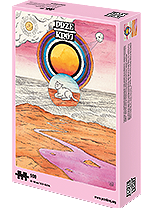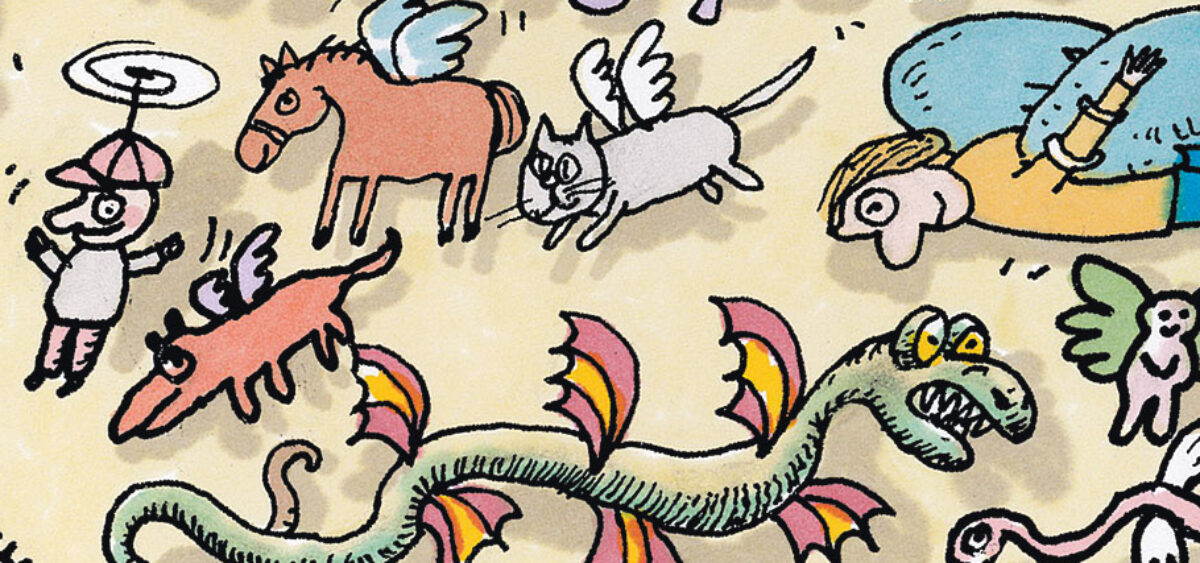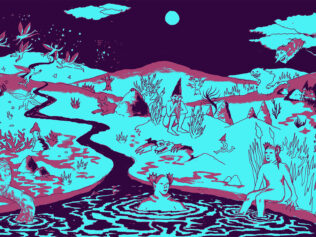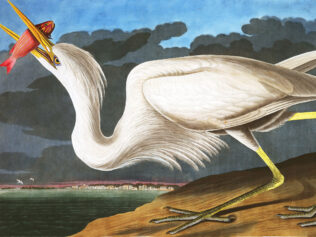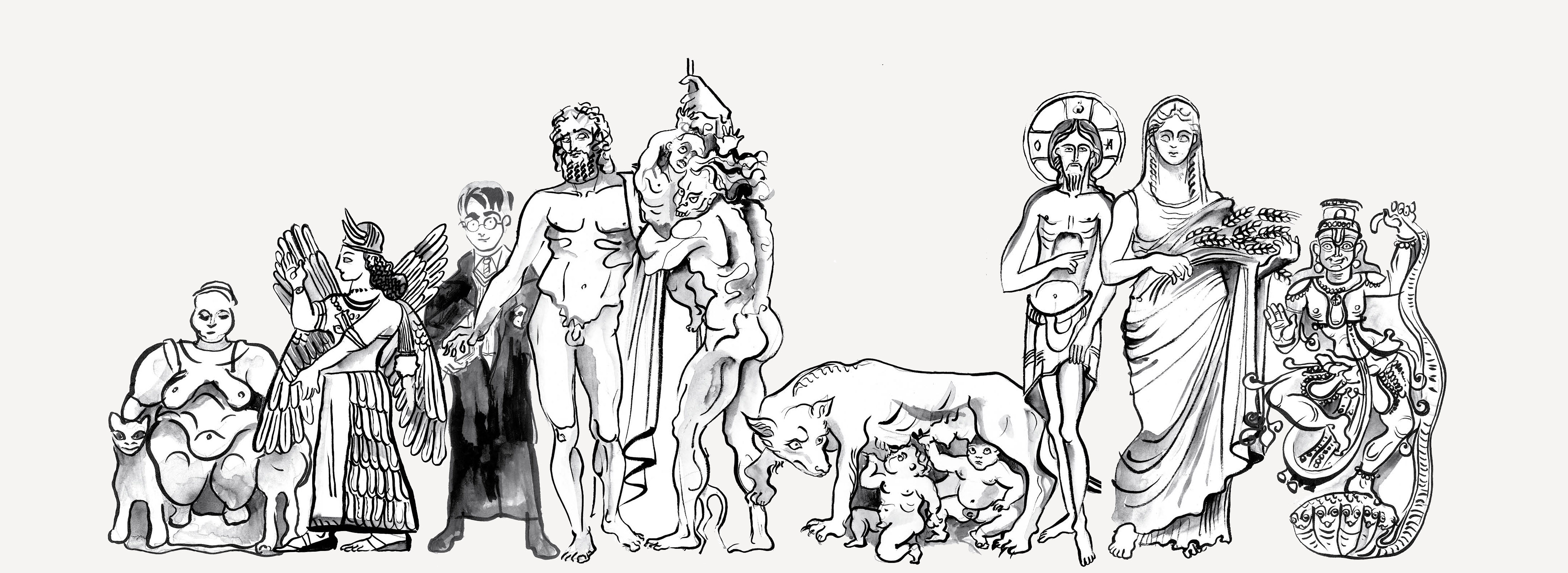
Those that leap and flutter through fairy tales, myths, legends, folk tales, epics and holy books.
If we examine the capacity to fly in terms of symbolism, we should take note of the fact that it is associated with the capacity to transcend, to break free of the boundaries of everyday life, with absolute freedom and with victory. Dreams about flying seem to confirm these observations, since we are often so excited that we wake up. In what is probably the oldest known form of religious experience – that is, shamanism – the shaman flies away to other kingdoms during a trance, experiencing ecstasy, healing, or making contact with the gods. Sometimes he wears a feather cloak to do so. The Rigveda, the oldest of the Vedas, the Hindu sacred texts, contains the following statement: “Those who know, have wings.” The sign that Taoist sages were reaching immortality was when they grew feathers. Many gods are portrayed with feathers or imagined as birds (for instance Osiris, Horus, Maat, Zeus). The ability to move through the air as seen in the animal kingdom has clearly always fascinated the human mind. In various cultures, such as those of the ancient Egyptians and the Slavs, birds symbolize the soul. Birds were also seen as intermediaries between men and gods, or their behaviour was used to predict the future (ornithomancy). At Jesus’s christening, the Holy Spirit took the form of a dove. And so on, and so forth.
Alongside ordinary zoology, there is also the infinitely abundant zoology of the fantastic; there seems to be no society that has failed to contribute to its development in the form of myths and legends. The area is so complicated, however, that any kind of classification appears impossible. When it comes to flying creatures, we can identify a broad class of creatures that could be defined as dragon-like, and another that have the enhanced features of large birds. Nonetheless, there is still an endless number of creatures that do not belong in either of these categories.
In this overview, I have taken into account the ones everyone is familiar with but which couldn’t go unmentioned, as well as ones that are undeservedly less well-known.
Phoenix
Where else could we begin if not the case of the miraculous phoenix? There are different accounts of where it comes from: contenders include Arabia, Lebanon, India and Egypt. What’s certain, however, is where and how it dies – it burns in Heliopolis on one of the sacrificial altars (according to some accounts, it fans the flames with the beating of its wings). Of course, it doesn’t actually die, but burns in order to be reborn from its ashes. Interestingly, there can only be one phoenix in the world at a time. Ancient and mediaeval authors disagree on the age at which it is born again: the two ends of the spectrum are given by Pliny (600 years) and Albert the Great (350 years). According to Ovid, the blood of a phoenix has healing properties. The creature is famous for its gentleness: it never harms or kills anything. Our world is governed by the tragic principle that in order to live you must kill some other form of life, but this principle does not apply to the phoenix, which lives only on morning dew. All of these features meant that in iconography the phoenix was quickly associated with Jesus Christ, as they essentially have a lot in common. Some early Christian theologians believed the Phoenix was the only bird that didn’t repeat Eve’s sin and devour the fruits that hung from the Tree of the Knowledge of Good and Evil, as the other birds did.
Dragon
According to Joseph Campbell, the American mythologist, the snake symbolizes life, not sin. It sheds its skin, is eternally reborn, and is a moving digestive system that we associate with the aforementioned idea of all living things endlessly eating each other (in this sense, traditions that identify the snake with sin are at odds with life, which they are only capable of recognizing through a ritual such as circumcision or baptism). The eagle is the symbol of the soul that rises above earthly life. It follows that the dragon is the symbol of perfection, in linking these two opposites. Perhaps that explains why dragons are so strong, never sleep, and can see everything. This ambivalence draws dragons in two opposing directions when it comes to how useful they are in the lives of humans: sometimes they are a symbol of heavenly power and light; at other times, a symbol of the underworld, destruction and evil. There does seem to be a tendency whereby the further East one looks, the more dragons are associated with positive characteristics, while in the West, they are creatures that must be defeated (though initially in Greece and Rome they were emblems of the emperors and the gods).
It’s worth adding that there are so many types of dragon, that the definition specifying that a dragon is just a cross between a snake and an eagle isn’t wholly satisfying. In the history of dragon representations, we see a whole carnival of hybrid creatures – that is, ones with the combined features of different animals whose existence is widely accepted today. These combinations are incredibly diverse. A Western dragon may have the head of an eagle, hawk or falcon, be covered in scales, with the forepaws of a lion or a bird, or vice versa. It may not have wings or legs at all. In Babylonian representations, a dragon’s tail becomes a scorpion’s sting. Sometimes, particularly in the Middle East, it can be difficult to distinguish a dragon from a griffin. It may have many heads, like the Greek Hydra or the seven-headed snake of the ancient Syrians, known as Typhon. A Chinese dragon, on the other hand, can have a camel’s head, a chicken’s torso, sometimes the body of a frog, or a cow’s ears, though it doesn’t use them for hearing (it has horns for that). It’s difficult to precisely define the form of a dragon, as the word covers a huge number of ideas; what’s curious is that nonetheless, everyone agrees on the term and some kind of unity of meaning can be felt across many of the depictions.
As mentioned above, in Middle Eastern and Western cultures, the dragon-monster-destroyer had to be defeated. It wasn’t just Saint George who battled one. We could mention by way of example the Babylonian Marduk who fought Tiamat, the Egyptian Horus who took on Typhon, Nordic Thor, and the Greek heroes: Perseus, who defeated Medusa; Apollo, conqueror of Python; Heracles, who slayed the Hydra. Zu, God of the Storm, took the form of a dragon; it was famous for having stolen the Tablet of Destinies, which gave it limitless power – it was again Marduk who dealt with him.
In the Far East, the dragon is a symbol of spiritual strength. It can live in the heavens but also in beautiful chambers at the bottom of bodies of water (Rinjin, the Japanese king of dragons, lived in a palace at the bottom of the ocean). The dragon is also one of the Chinese signs of the zodiac. The predecessors of the Chinese emperors were said to have been dragons that ruled China. They are symbols of everything that is sacred and supernatural. In Japan, there was a tradition of dragons that turned into birds. One of these dragons was the white Goncho. After 50 years as a dragon, it became a golden bird. Its cry was a bad omen: the sign of impending famine.
It’s actually quite astonishing how common dragons are.
Roc
An Arabian bird of impressive dimensions. It can cover the sun with its giant wings; indeed, the sun is nothing other than its enormous egg. It feeds its young on elephants. When it flies across the sky, lightning bolts flash in its wake; the beating of its wings causes gales. For this reason, it falls into the category of so-called storm birds. The Roc lives in the air and never touches the ground, with one exception: when it lands on Mount Qaf, the centre of the world. Snakes, including sea-snakes, fear it. It appears in Sinbad’s second voyage. In his Description of the World, Marco Polo included the testimonies of people who had seen it.
Simurgh
A Persian relative of the Roc. It is equally huge, but resembles a mammal because it suckles its young. Indo-European cultures recall a sacred plant, still not properly identified today, which was used to produce the ritual drug, haoma (the Indian Vedas speak of ‘soma’). The Simurgh lives in the kingdom of these plants. It roosts on the Tree of Life. It can predict the future and its feathers have healing powers. It lives for 1700 years; it is clearly a relative of the phoenix, because when it sees its young reaching adulthood, it bursts into flames and dies. Just like the Roc, it terrorizes snakes.
Garuda
One of the oldest mythical birds known to mankind. King of the birds. It, too, can cover the sun with its wings. It has human features (a white face), a golden torso and red wings. It is ridden by the God Vishnu. Once upon a time, it was granted permission to eat evil people, but – curiously – with the exception of brahmins. This suggests it might have been at least partly thought up by a brahmin. Of course, it sows panic among serpents.
Ziz
Another enormous bird, this time coming from the Hebrew tradition. Behemoth rules the land; Leviathan reigns over the sea; Ziz’s kingdom is the sky. When the Messiah comes, He will vanquish all three, and then, once properly cooked, they will be eaten by the righteous during a post-apocalyptic feast.
Buraq
Less well-known to Europeans, but an important creature in Muslim cultures. It is a winged white stallion, ridden by Mohammed when he journeyed to the heavens as a prophet, and as he travelled between Mecca and Jerusalem. It allegedly also carried other prophets, and perhaps still does.
The cinnamon bird
A curious case described by Herodotus. A large bird that occasionally came to Arabia (from an unknown location), carrying a cinnamon stick in its beak, which it used to build its nest. Spice traders tried numerous ways to cause this nest, which was always built high up, to fall to the ground.
Harpy
In the Greco-Roman world, harpies probably started out simply as female creatures with beautiful hair and wings, who could move faster than the wind; only gradually did they become monstrous and ugly. Ultimately their head and chest remained like those of a woman, but their body became that of a vulture, whose claws and wings gave off an unbearable stench. Associated with whirlwinds, sudden death and stealing the souls of sinners, they are also an instrument of divine justice, inflicting cruel punishment.
Griffin
According to art historians, this is one of the most unchanging hybrid creatures. It is a cross between a lion and a bird, the oldest images of which come from the lands of Egypt and Mesopotamia, and it has survived to this day in basically the same form (there were some variations on the griffin, such as the Scythian griffin with fins instead of wings, but they are the minority). Ancient authors believed that the griffin lived in the Indian mountains, in nests built of gold. It guarded the entrance to mines of this precious ore. Later, the symbolism of the griffin, like the phoenix, was associated with the symbolism of the Christian Saviour.
The cloud-swallowing dragon
This is a very interesting case of a creature that comes from Poland. The cloud-swallowing dragon lives high above the clouds and is not a direct threat to people. The problem is that sometimes, when it swallows too many clouds, it causes a drought. Even in the 1930s, researchers still found individuals in rural communities who claimed to have seen this dragon.
Sphinx
Not all sphinxes flew. There are both male sphinxes (in Egypt) and female ones (in Greece). Only the latter had wings. The sphinx is the symbol of a theological secret: it guards shrines and access to esoteric knowledge, and it poses riddles. Oedipus managed to solve one, which made the sphinx commit suicide. Clearly, when a secret stops existing, the sphinx loses its raison d’être. Like the griffin, the image of the sphinx is particularly old and unchanged in human history.
Hercynia
We know about these birds from the writings of Pliny. They apparently lived (or still live) in Germany, in the Hercynian Forest. These creatures’ feathers have extraordinary properties: at night they shine as brightly as if they were burning. In this way, they have more than once aided ancient travellers in finding their way in the darkness.
Kestrel
The only representative of the Australian continent in this overview. This bird is the spiritual guardian of warriors. It was born one day as the unexpected result of a conflict between Aboriginal tribes. One of the clashes caused a fire and the kestrel emerged from the ashes left behind. It seems unlikely that the Aborigines had come across the figure of the phoenix, and yet here we find the same motif of birth from the ashes.
Pajură
A tragic bird found in Romanian folklore. Unable to stand the company of its children, it kills them. But in its growing sorrow it rips open its own breast. The children then return to life, but the pajură dies.
Dijiang
A Chinese bird that can be found in the heavenly mountains. Colour: red. Legs: three pairs. Wings: two pairs. Other features: it has no eyes, or indeed any face at all.
Mixcoatl
This was the name given by the Aztecs, but other neighbouring tribes also knew this creature. A heavenly snake-dragon, without one sole form. It could be a rabbit, a deer or a racing cloud.
Thunderbird
A giant bird known to indigenous people across the whole of North America. It looks like an eagle, falcon and at the same time a thunderclap and a whirlwind. It is a powerful spirit. It carries a lake on its back that is the source of all rain. It releases lightning bolts from its eyes. It feeds on whales.
Tengu
A Japanese bird-man. It is very jealous of the cult surrounding the Buddha; it hates Buddhists. It likes to haunt dark and deserted nooks and crannies, sending people mad and inspiring conflict, including armed clashes. How can it be identified? Its wings, bird’s talons and unnaturally glowing eyes. A priest who falls short in religious commitment turns into a tengu.
Three-legged raven
Found in the mythology of China, Korea and Japan (Yatagarasu). It is linked to solar gods and acts as a divine messenger. According to some accounts, it lives on the sun – if you manage to see a spot on that star, then you know who or what caused it.
Makuragaeshi (the pillow flipper)
A visually undefined creature that flies over the head of a sleeping samurai. What does it do? It moves pillows around the bed. This wakes the samurai and really annoys him.
Egg
Let’s conclude our overview with a question. In the different corners of our planet, we find myths about the creation of the world (for instance in Egyptian, Indian, Finnish and Orphic mythology) with the recurring theme of a cosmic egg from which the Earth hatched (according to some academics, the Polish custom of painting pisanki – brightly decorated Easter Eggs – comes from this archaic conception). It follows that something had to lay it – a Superbeing that laid the Cosmic Egg. And what seems more likely: that it was a creature that crawled, swam, walked or flew?

